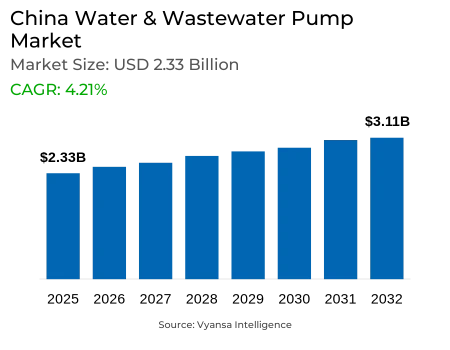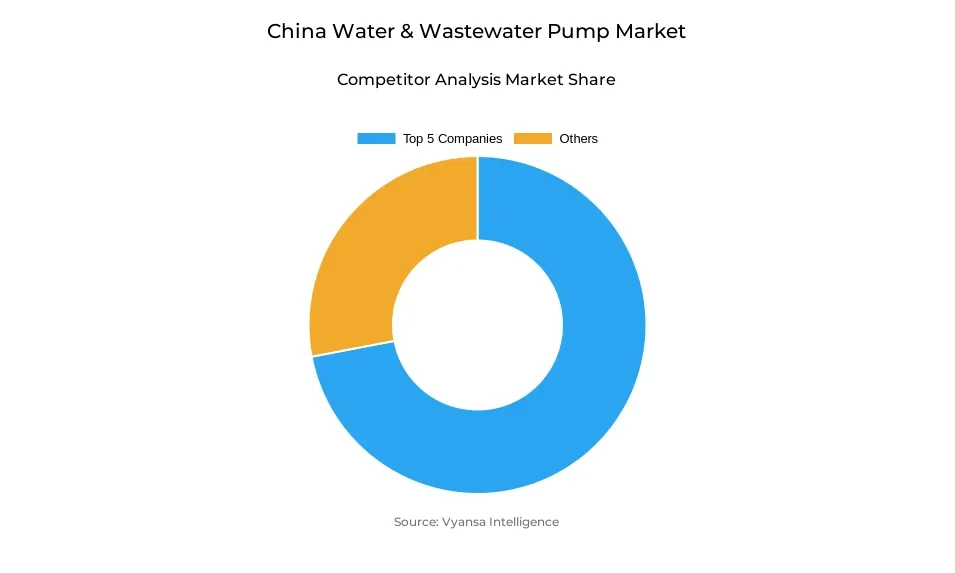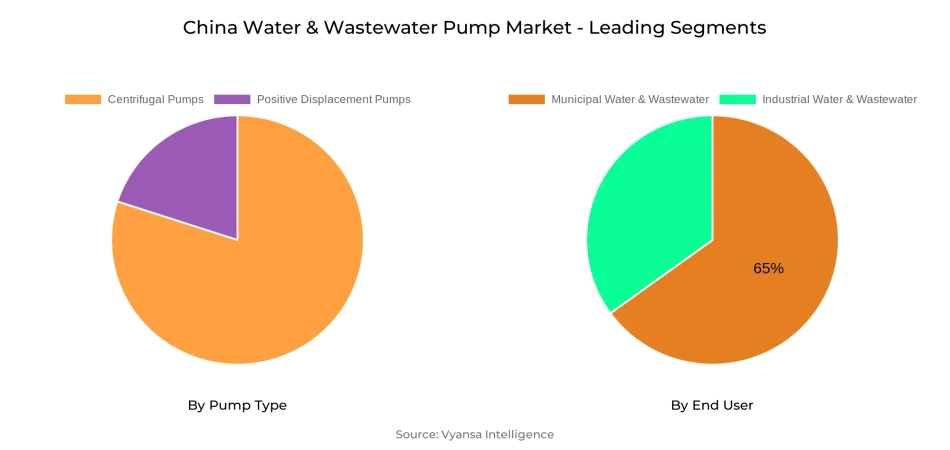China Water & Wastewater Pump Market Report: Trends, Growth and Forecast (2026-2032)
By Pump Type (Centrifugal Pumps (End Suction, Split Case, Vertical (Turbine, Axial Pump, Mixed Flow Pump), Submersible Pump), Positive Displacement Pumps (Progressing Cavity, Diaphragm, Gear Pump, Others)), By Application (Water, Wastewater), By End User (Industrial Water & Wastewater, Municipal Water & Wastewater)
- Energy & Power
- Dec 2025
- VI0477
- 110
-




China Water & Wastewater Pump Market Statistics and Insights, 2026
- Market Size Statistics
- Water & Wastewater Pump in China is estimated at $ 2.33 Billion.
- The market size is expected to grow to $ 3.11 Billion by 2032.
- Market to register a CAGR of around 4.21% during 2026-32.
- Pump Type Segment
- Centrifugal Pumps continues to dominate the market.
- Competition
- More than 10 companies are actively engaged in producing Water & Wastewater Pump in China.
- Top 5 companies acquired the maximum share of the market.
- ITT, IDEX, Dover, Flowserve, Sulzer AG etc., are few of the top companies.
- End User
- Municipal Water & Wastewater grabbed 65% of the market.
China Water & Wastewater Pump Market Outlook
The China Water & Wastewater Pump Market is USD 2.33 billion in 2025 and is expected to reach USD 3.11 billion by 2032, showing consistent growth as the government remains focused on safe and sustainable water infrastructure. With 95% of the urban population already covered by safely managed systems, new standards for pump efficiency are pushing utilities to invest in high-performance equipment. Low-interest financing programs further facilitate these upgrades, allowing utilities to save on operating costs while complying with tighter water-quality and energy-use standards.
Although there has been improvement, China is still confronted by aging water infrastructure, with non-revenue water losses averaging 21% in the urban regions. Leaking pipes and old pump stations require incessant repairs, boosting expenditures and undermining supply reliability. All this has served to raise the need for durable pumps that can operate under fluctuating pressures and reduce unscheduled downtime, and as such, modernization is a priority area for municipal governments.
Technological uptake is also transforming the market, with close to 40% of utilities incorporating IoT-based sensors for real-time monitoring. Predictive maintenance and distant diagnostics are aiding operators to identify faults at an early stage, streamline pump schedules, and enhance energy efficiency. The increasing use of digital tools indicates a trend toward end-to-end automated, reliable water and wastewater pumping systems throughout urban networks.
From a segment standpoint, centrifugal pumps lead with the highest share, used in more than three-quarters of urban water and wastewater applications because they are cost-effective and versatile. Based on end user, municipal water and wastewater utilities have the largest share at 65% to address the nation's emphasis on serving urban demand. Industrial water and wastewater, on the other hand, is the fastest-growing segment as it is favored by increasing manufacturing and energy industries that make wider use of wastewater recycling and reuse.

China Water & Wastewater Pump Market Growth Driver
Rising Compliance Pressure Accelerating Market Growth
The government of China is increasing water infrastructure investment to deliver safe drinking water, and 95% of the population in urban areas is now covered by safely managed services according to WHO/UNICEF JMP. New regulations enforce high-efficiency pump standards, forcing the use of high-performance equipment throughout municipal systems.
This regulatory drive heightens demand for efficient pumping technology, as utilities replace outdated equipment to meet tighter water quality and energy-use standards. Incentives like low-interest financing programs accelerate purchasing of new pumps that cut down on costs and minimize environmental footprint.
China Water & Wastewater Pump Market Challenge
Aging Network Integrity Hindering Market Growth
China is confronted with serious challenges of aging water networks, with the average losses in non-revenue water in urban systems at 21% as per UN-Water. Leaking pipelines and aging pump stations undermine service continuity and compel the utilities into recurrent emergency repairs.
These infrastructure gaps raise maintenance costs and interfere with supply reliability, making long-term planning difficult for water and sewer authorities. They require reliable pumping solutions that will work optimally in variable pressure conditions and reduce unplanned downtime.
China Water & Wastewater Pump Market Trend
Optimizing Utility Operations through Rapid Adoption of Smart Monitoring Solutions
Smart monitoring is on the rise, with around 40% of Chinese utilities installing IoT-enabled sensors in pump stations to drive in-situ optimization in real time. Remote diagnosis and predictive maintenance algorithms assist in identifying problems before they lead to failure and improve equipment life.
This data-driven strategy enables the operators to fine-tune pump scheduling, decrease energy usage and enhance water delivery balance between service areas. The high adoption rate of digital solutions indicates a trend toward totally automated, strong pumping infrastructures.
China Water & Wastewater Pump Market Opportunity
Expanding Wastewater Reuse Strengthening Demand for Advanced Pumping Technologies
China's wastewater reuse rate is 23% of total effluent, according to UN-Water data, offering major opportunities for growth for pump manufacturers. Inexpanding freshwater constraints for cities and industry are driving more treated wastewater to be used for irrigation, cooling and industrial uses.
This trend generates demand for pumps that can manage variable water quality and flow rates. Manufacturers can make the most of this trend through the provision of corrosion- and abrasion-resistant pumps designed specifically for reuse applications, fueling market growth.
China Water & Wastewater Pump Market Segmentation Analysis

By Pump Type
- Centrifugal Pumps
- Positive Displacement Pumps
The most significant market share in the segment of Pump Type is Centrifugal Pumps, since these remain the industry leaders because of their simplicity, broad flow range and cost savings. The centrifugal versions cater to more than three-quarters of urban water and wastewater service, satisfying varying pressure demands at low maintenance.
Positive displacement units are still critical for certain high-pressure or high-viscosity applications, but centrifugal designs drive aggregate demand due to the mature infrastructure compatibility and scalable performance profiles.
By End User
- Industrial Water & Wastewater
- Municipal Water & Wastewater
The most dominant segment under End User with the highest market share is Municipal Water & Wastewater, which accounts for 65% of all pump applications in China's water industry. Municipal utilities want dependable, high-volume pumping systems to supply increasing urban populations and achieve demanding service standards.
Industrial Water & Wastewater stands out as the fastest-growing segment, recording a 6.27% CAGR supported by growth in manufacturing, power generation and chemical processing industries that have a need for exacting wastewater recycling and wastewater management solutions.
Top Companies in China Water & Wastewater Pump Market
The top companies operating in the market include ITT, IDEX, Dover, Flowserve, Sulzer AG, KSB, Xylem, Grundfos, Ebara, SPX Flow, etc., are the top players operating in the China Water & Wastewater Pump Market.
Frequently Asked Questions
Related Report
1. Market Segmentation
1.1. Research Scope
1.2. Research Methodology
1.3. Definitions and Assumptions
2. Executive Summary
3. China Water & Wastewater Pump Market Policies, Regulations, and Standards
4. China Water & Wastewater Pump Market Dynamics
4.1. Growth Factors
4.2. Challenges
4.3. Trends
4.4. Opportunities
5. China Water & Wastewater Pump Market Statistics, 2022-2032F
5.1. Market Size & Growth Outlook
5.1.1.By Revenues in US$ Million
5.2. Market Segmentation & Growth Outlook
5.2.1.By Pump Type
5.2.1.1. Centrifugal Pumps- Market Insights and Forecast 2022-2032, USD Million
5.2.1.1.1. End Suction- Market Insights and Forecast 2022-2032, USD Million
5.2.1.1.2. Split Case- Market Insights and Forecast 2022-2032, USD Million
5.2.1.1.3. Vertical- Market Insights and Forecast 2022-2032, USD Million
5.2.1.1.3.1. Turbine- Market Insights and Forecast 2022-2032, USD Million
5.2.1.1.3.2. Axial Pump- Market Insights and Forecast 2022-2032, USD Million
5.2.1.1.3.3. Mixed Flow Pump- Market Insights and Forecast 2022-2032, USD Million
5.2.1.1.4. Submersible Pump- Market Insights and Forecast 2022-2032, USD Million
5.2.1.2. Positive Displacement Pumps- Market Insights and Forecast 2022-2032, USD Million
5.2.1.2.1. Progressing Cavity- Market Insights and Forecast 2022-2032, USD Million
5.2.1.2.2. Diaphragm- Market Insights and Forecast 2022-2032, USD Million
5.2.1.2.3. Gear Pump- Market Insights and Forecast 2022-2032, USD Million
5.2.1.2.4. Others- Market Insights and Forecast 2022-2032, USD Million
5.2.2.By Application
5.2.2.1. Water- Market Insights and Forecast 2022-2032, USD Million
5.2.2.2. Wastewater- Market Insights and Forecast 2022-2032, USD Million
5.2.3.By End User
5.2.3.1. Industrial Water & Wastewater- Market Insights and Forecast 2022-2032, USD Million
5.2.3.2. Municipal Water & Wastewater- Market Insights and Forecast 2022-2032, USD Million
5.2.4.By Competitors
5.2.4.1. Competition Characteristics
5.2.4.2. Market Share & Analysis
6. China Centrifugal Water & Wastewater Pump Market Statistics, 2020-2030F
6.1. Market Size & Growth Outlook
6.1.1.By Revenues in US$ Million
6.2. Market Segmentation & Growth Outlook
6.2.1.By Pump Type- Market Insights and Forecast 2022-2032, USD Million
6.2.2.By Application- Market Insights and Forecast 2022-2032, USD Million
6.2.3.By End User- Market Insights and Forecast 2022-2032, USD Million
7. China Positive Displacement Water & Wastewater Pump Market Statistics, 2020-2030F
7.1. Market Size & Growth Outlook
7.1.1.By Revenues in US$ Million
7.2. Market Segmentation & Growth Outlook
7.2.1.By Pump Type- Market Insights and Forecast 2022-2032, USD Million
7.2.2.By Application- Market Insights and Forecast 2022-2032, USD Million
7.2.3.By End User- Market Insights and Forecast 2022-2032, USD Million
8. Competitive Outlook
8.1. Company Profiles
8.1.1.Flowserve Corporation
8.1.1.1. Business Description
8.1.1.2. Product Portfolio
8.1.1.3. Collaborations & Alliances
8.1.1.4. Recent Developments
8.1.1.5. Financial Details
8.1.1.6. Others
8.1.2.Ebara Corporation
8.1.2.1. Business Description
8.1.2.2. Product Portfolio
8.1.2.3. Collaborations & Alliances
8.1.2.4. Recent Developments
8.1.2.5. Financial Details
8.1.2.6. Others
8.1.3.WILO SE
8.1.3.1. Business Description
8.1.3.2. Product Portfolio
8.1.3.3. Collaborations & Alliances
8.1.3.4. Recent Developments
8.1.3.5. Financial Details
8.1.3.6. Others
8.1.4.Sulzer Limited
8.1.4.1. Business Description
8.1.4.2. Product Portfolio
8.1.4.3. Collaborations & Alliances
8.1.4.4. Recent Developments
8.1.4.5. Financial Details
8.1.4.6. Others
8.1.5.Grundfos Holding A/S
8.1.5.1. Business Description
8.1.5.2. Product Portfolio
8.1.5.3. Collaborations & Alliances
8.1.5.4. Recent Developments
8.1.5.5. Financial Details
8.1.5.6. Others
8.1.6.Xylem Inc.
8.1.6.1. Business Description
8.1.6.2. Product Portfolio
8.1.6.3. Collaborations & Alliances
8.1.6.4. Recent Developments
8.1.6.5. Financial Details
8.1.6.6. Others
8.1.7.KSB SE & Co. KGaA
8.1.7.1. Business Description
8.1.7.2. Product Portfolio
8.1.7.3. Collaborations & Alliances
8.1.7.4. Recent Developments
8.1.7.5. Financial Details
8.1.7.6. Others
8.1.8.Kirloskar Brothers Limited (KBL)
8.1.8.1. Business Description
8.1.8.2. Product Portfolio
8.1.8.3. Collaborations & Alliances
8.1.8.4. Recent Developments
8.1.8.5. Financial Details
8.1.8.6. Others
8.1.9.Franklin Electric
8.1.9.1. Business Description
8.1.9.2. Product Portfolio
8.1.9.3. Collaborations & Alliances
8.1.9.4. Recent Developments
8.1.9.5. Financial Details
8.1.9.6. Others
8.1.10. Pentair PLC
8.1.10.1. Business Description
8.1.10.2. Product Portfolio
8.1.10.3. Collaborations & Alliances
8.1.10.4. Recent Developments
8.1.10.5. Financial Details
8.1.10.6. Others
9. Disclaimer
| Segment | Sub-Segment |
|---|---|
| By Pump Type |
|
| By Application |
|
| By End User |
|
Research Methodology
This study followed a structured approach comprising four key phases to assess the size and scope of the electro-oxidation market. The process began with thorough secondary research to collect data on the target market, related markets, and broader industry context. These findings, along with preliminary assumptions and estimates, were then validated through extensive primary research involving industry experts from across the value chain. To calculate the overall market size, both top-down and bottom-up methodologies were employed. Finally, market segmentation and data triangulation techniques were applied to refine and validate segment-level estimations.
Secondary Research
The secondary research phase involved gathering data from a wide range of credible and published sources. This step helped in identifying industry trends, defining market segmentation, and understanding the market landscape and value chain.
Sources consulted during this phase included:
- Company annual reports, investor presentations, and press releases
- Industry white papers and certified publications
- Trade directories and market-recognized databases
- Articles from authoritative authors and reputable journals
- Gold and silver standard websites
Secondary research was critical in mapping out the industry's value chain and monetary flow, identifying key market segments, understanding regional variations, and tracking significant industry developments.
Other key sources:
- Financial disclosures
- Industry associations and trade bodies
- News outlets and business magazines
- Academic journals and research studies
- Paid industry databases
Primary Research
To validate secondary data and gain deeper market insights, primary research was conducted with key stakeholders across both the supply and demand sides of the market.
On the demand side, participants included decision-makers and influencers from end-user industries—such as CIOs, CTOs, and CSOs—who provided first-hand perspectives on market needs, product usage, and future expectations.
On the supply side, interviews were conducted with manufacturers, industry associations, and institutional participants to gather insights into current offerings, product pipelines, and market challenges.
Primary interviews provided critical inputs such as:
- Market size and revenue data
- Product and service breakdowns
- Market forecasts
- Regional and application-specific trends
Stakeholders consulted included:
- Leading OEM and solution providers
- Channel and distribution partners
- End users across various applications
- Independent consultants and industry specialists
Market Size Estimation and Data Triangulation
- Identifying Key Market Participants (Secondary Research)
- Goal: To identify the major players or companies in the target market. This typically involves using publicly available data sources such as industry reports, market research publications, and financial statements of companies.
- Tools: Reports from firms like Gartner, Forrester, Euromonitor, Statista, IBISWorld, and others. Public financial statements, news articles, and press releases from top market players.
- Extracting Earnings of Key Market Participants
- Goal: To estimate the earnings generated from the product or service being analyzed. This step helps in understanding the revenue potential of each market player in a specific geography.
- Methods: Earnings data can be gathered from:
- Publicly available financial reports (for listed companies).
- Interviews and primary data sources from professionals, such as Directors, VPs, SVPs, etc. This is especially useful for understanding more nuanced, internal data that isn't publicly disclosed.
- Annual reports and investor presentations of key players.
- Data Collation and Development of a Relevant Data Model
- Goal: To collate inputs from both primary and secondary sources into a structured, data-driven model for market estimation. This model will incorporate key market KPIs and any independent variables relevant to the market.
- Key KPIs: These could include:
- Market size, growth rate, and demand drivers.
- Industry-specific metrics like market share, average revenue per customer (ARPC), or average deal size.
- External variables, such as economic growth rates, inflation rates, or commodity prices, that could affect the market.
- Data Modeling: Based on this data, the market forecasts are developed for the next 5 years. A combination of trend analysis, scenario modeling, and statistical regression might be used to generate projections.
- Scenario Analysis
- Goal: To test different assumptions and validate how sensitive the market is to changes in key variables (e.g., market demand, regulatory changes, technological disruptions).
- Types of Scenarios:
- Base Case: Based on current assumptions and historical data.
- Best-Case Scenario: Assuming favorable market conditions, regulatory environments, and technological advancements.
- Worst-Case Scenario: Accounting for adverse factors, such as economic downturns, stricter regulations, or unexpected disruptions.
Partnering With Industry Leaders to Drive Growth
Our mission is to deliver intelligence that matters. By combining data, analysis, and industry expertise, we enable organizations to make smarter, faster, and more impactful decisions. Whether it’s a Fortune 500 company or a high-growth startup, businesses trust us to provide clarity in an ever-evolving marketplace.






